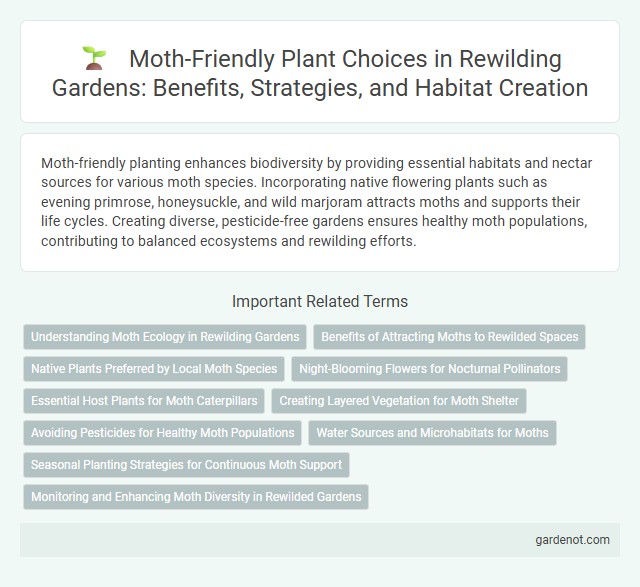Moth-friendly planting enhances biodiversity by providing essential habitats and nectar sources for various moth species. Incorporating native flowering plants such as evening primrose, honeysuckle, and wild marjoram attracts moths and supports their life cycles. Creating diverse, pesticide-free gardens ensures healthy moth populations, contributing to balanced ecosystems and rewilding efforts.
Understanding Moth Ecology in Rewilding Gardens
Understanding moth ecology is crucial for designing moth-friendly planting in rewilding gardens, as moths serve as essential pollinators and indicators of ecosystem health. Selecting native plant species that provide nectar sources and larval host plants creates a habitat supporting diverse moth populations. Dark, undisturbed areas for nocturnal activity and seasonal plant variation further enhance moth survival and reproduction.
Benefits of Attracting Moths to Rewilded Spaces
Moth-friendly planting enhances biodiversity by providing crucial food sources and habitats for various moth species, which serve as essential pollinators and nocturnal ecosystem contributors. Attracting moths to rewilded spaces supports food webs, benefiting birds, bats, and other wildlife reliant on moths for nutrition. Promoting these plants also helps restore natural ecological balance and increases resilience against environmental changes.
Native Plants Preferred by Local Moth Species
Moth-friendly planting emphasizes the use of native plants preferred by local moth species to support their life cycles and biodiversity. These native plants provide essential nectar sources and larval host plants, promoting healthy moth populations and contributing to ecosystem balance. Prioritizing region-specific flora enhances habitat quality and resilience in rewilding projects.
Night-Blooming Flowers for Nocturnal Pollinators
Night-blooming flowers such as evening primrose, moonflower, and night-scented stock provide essential nectar sources for nocturnal pollinators like moths and bats, supporting biodiversity in rewilding projects. These plants emit strong fragrances and pale-colored blooms that attract moths, facilitating pollination during nighttime hours when diurnal insects are inactive. Incorporating native night-flowering species enhances habitat connectivity and promotes natural ecosystem regeneration by sustaining nocturnal pollinator populations.
Essential Host Plants for Moth Caterpillars
Essential host plants for moth caterpillars include native species such as oak (Quercus spp.), willow (Salix spp.), and hawthorn (Crataegus monogyna), which provide vital nourishment for larval development. Incorporating diverse herbaceous plants like nettles (Urtica dioica) and bedstraw (Galium spp.) supports a wider range of moth species by supplying critical food sources. Prioritizing these native host plants in rewilding projects enhances moth populations and promotes biodiversity within local ecosystems.
Creating Layered Vegetation for Moth Shelter
Creating layered vegetation with native shrubs, tall grasses, and flowering plants provides essential shelter and nocturnal foraging sites for moths, enhancing local biodiversity. This stratified plant structure mimics natural habitats, supporting different moth species at various life stages by offering protection from predators and harsh weather. Incorporating diverse plant heights and textures ensures continuous cover, promoting moth population resilience and ecological balance.
Avoiding Pesticides for Healthy Moth Populations
Avoiding pesticides is crucial for maintaining healthy moth populations, as these chemicals disrupt their life cycles and reduce available food sources. Planting native, moth-friendly flora supports caterpillar development and adult moth feeding while minimizing chemical exposure. Creating pesticide-free habitats promotes biodiversity and strengthens local ecosystems by preserving essential moth species.
Water Sources and Microhabitats for Moths
Creating water sources such as shallow puddles and damp soil areas supports moth hydration and nutrient intake essential for reproduction and survival. Incorporating diverse microhabitats like leaf litter, hollow stems, and native flowering plants provides shelter, breeding sites, and larval food sources critical for sustaining moth populations. Strategic placement of these elements enhances habitat complexity, promoting biodiversity and contributing to successful rewilding efforts.
Seasonal Planting Strategies for Continuous Moth Support
Seasonal planting strategies for continuous moth support prioritize native flowering plants that bloom at different times throughout the year, ensuring a steady food source for moths across all life stages. Incorporating a mix of spring bulbs, summer perennials, and autumn-flowering shrubs creates diverse habitats that support moth populations' feeding and breeding needs. Selecting night-scented and nectar-rich plants enhances attraction and sustenance for nocturnal moth species vital to ecosystem rewilding efforts.
Monitoring and Enhancing Moth Diversity in Rewilded Gardens
Regular monitoring of moth populations in rewilded gardens through light traps and pheromone lures provides critical data on species diversity and abundance. Planting native wildflowers, night-scented plants, and host species like oak or willow supports larval development and adult moth activity. Enhancing moth diversity enriches local ecosystems by promoting pollination networks and serving as a food source for birds and bats, strengthening ecological resilience.
Moth-friendly planting Infographic

 gardenot.com
gardenot.com